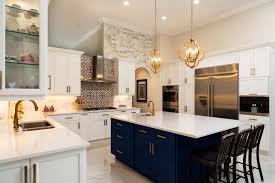Not every home upgrade needs to be a full-scale renovation. In fact, some of the most effective improvements are the ones that enhance your daily experience, one room at a time. When approaching all home improvements, it’s important to prioritize what matters most—comfort, function, and the way each space supports your lifestyle.
Rather than getting overwhelmed by an endless list of updates, a room-by-room strategy can bring clarity to the process. This method allows homeowners to plan smarter, invest wisely, and create a cohesive vision for their interiors without feeling pressured to do everything at once.
So, where should you begin? Let’s walk through your home to explore the most impactful improvements room by room—and how to decide which projects deserve top priority.
Entryway: Start With a Strong First Impression
The entryway sets the tone for your entire home. While it may be a small space, the impact it makes is significant. Prioritizing this area is about creating organization, functionality, and visual flow.
Some high-impact improvements include:
- Upgrading lighting for a brighter, more welcoming ambiance
- Replacing flooring with durable materials that resist dirt and moisture
- Adding built-in or wall-mounted storage for shoes, coats, and keys
- Painting or refinishing the front door and surrounding trim
Even minor updates here can influence how the rest of your home feels. A clean, well-designed entry provides a psychological transition between the outside world and your living space.
Living Room: Balance Aesthetics With Practical Use
As the social heart of the home, the living room should offer both comfort and style. Whether you’re entertaining guests or relaxing with family, this space sees a wide range of activity—and wear.
Improvements worth prioritizing here include:
- Updating flooring for durability and ease of maintenance
- Installing built-in shelving to maximize vertical space
- Reconfiguring lighting with dimmers, layered fixtures, or recessed options
- Refreshing walls with neutral colors or subtle accents for timeless appeal
When considering all home improvements, the living room provides excellent return on investment both functionally and visually. It’s one of the first places people gather and spend time, so every upgrade feels instantly rewarding.
Kitchen: High-Function Meets High-Impact
The kitchen is often referred to as the home’s hub—and for good reason. It blends function, daily routine, and design all in one. Because of this, even modest changes can dramatically shift how the space works for you.
Top priorities here include:
- Replacing outdated countertops with modern, low-maintenance materials
- Refacing or repainting cabinets instead of full replacement
- Installing under-cabinet lighting for both task use and ambiance
- Upgrading hardware, fixtures, and appliances for efficiency
If a full renovation isn’t in the budget, strategic updates still go a long way. Prioritize layout and workflow first, followed by materials and finishes that offer long-term durability.
Bathrooms: Think Function and Water Efficiency
Bathrooms are smaller spaces, but they come with plenty of potential. When planning improvements, think about how the space functions for its users—and how it can do more with better fixtures, lighting, and storage.
Consider upgrades such as:
- Swapping out outdated vanities for modern floating styles
- Installing low-flow toilets and fixtures for water savings
- Replacing tiles with mold-resistant, easy-to-clean materials
- Improving ventilation to preserve indoor air quality
In the world of all home improvements, bathrooms often offer one of the highest returns, especially when the changes make the room more comfortable and efficient.
Bedrooms: Comfort and Customization Matter Most
Bedrooms are personal spaces. They’re not just where you sleep—they’re where you recharge. Improvements here should focus on comfort, storage, and ambiance.
Recommended updates include:
- Installing blackout shades or layered window treatments
- Repainting with calming, muted tones to improve restfulness
- Adding custom closets or organizers to maximize space
- Upgrading lighting to include both soft and task-specific options
Unlike public areas of the home, bedroom updates can be more tailored to your personality and routine. Even simple changes can greatly improve daily life.
Home Office: Functionality Is the Priority
As remote work becomes more common, having a dedicated home office has shifted from luxury to necessity. Designing this space for productivity and comfort is one of the smartest modern upgrades.
Focus on:
- Enhancing lighting to reduce eye strain
- Installing soundproofing materials or acoustic panels
- Upgrading flooring for a professional appearance and minimal maintenance
- Creating custom cabinetry or shelving for organization
Even if space is limited, converting a spare corner or unused room into a functional workspace adds serious value. When done well, it supports not only work but also study, hobbies, and creativity.
Hallways and Transitional Spaces: Don’t Overlook the In-Between
Hallways, stairwells, and transitional spaces often get the least attention—but these areas contribute to flow, mood, and cohesion throughout your home.
Simple improvements here include:
- Upgrading lighting fixtures or adding sconces for visual interest
- Painting walls in neutral tones for connection between rooms
- Adding storage nooks, art, or architectural trim for detail
When overlooked, these spaces can feel dark or disconnected. When improved, they enhance the entire home’s experience—without the need for major investment.
Planning by Priority: What Comes First?
Rather than focusing on every room at once, a priority-based plan ensures progress without overwhelm. Here’s how to think about where to start:
- Daily Impact: Which spaces do you use most?
- Functionality: Where do you encounter frustration or inefficiency?
- Wear and Tear: What areas show the most aging or damage?
- Budget Efficiency: What improvements offer high visual return with lower cost?
- Cohesion: Will one upgrade affect another down the line?
A phased approach lets you address immediate needs while planning for bigger changes later. That’s the most effective way to manage all home improvements—with intention, purpose, and strategic timing.
Final Thoughts: One Room at a Time Adds Up
Improving your home doesn’t require gutting it or committing to every renovation idea at once. By looking at each room through a lens of use, comfort, and potential, you can make smarter decisions that build on one another over time.
Each space tells a story. When improved with care, those stories align to form a home that truly supports your lifestyle.
Whether you’re updating a single room or planning a full home overhaul, working with experienced professionals like Gikas Painting & Contracting ensures that every detail—from layout to materials—is designed with intention.
After all, the best results don’t come from doing everything at once. They come from doing the right things, in the right order, with the right plan.






